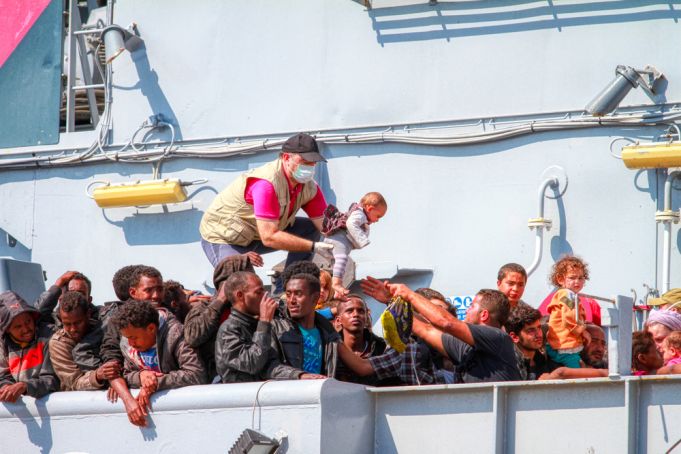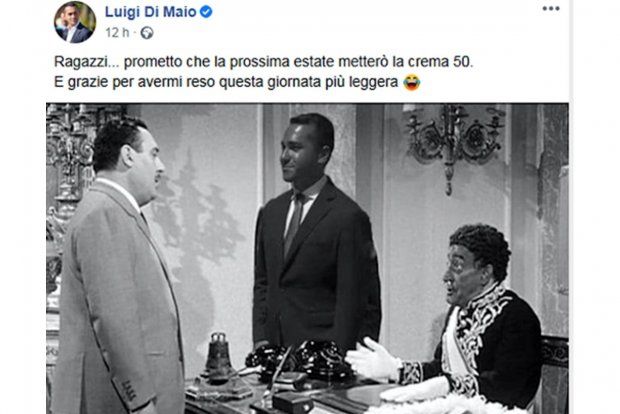Is Italy Racist?
At the center of the debate, an uncomfortable question resided: Is Italy racist?
In early November 2019, Louis Pisano, a Milan-based Black social media influencer and writer, went on an Instagram rant condemning the television show Tale e Quale.
Tale e Quale is a televised singing competition that airs on RAI 1, Italy’s national broadcast channel. More than a singing competition, it is an impersonation competition: contestants use makeup, wigs, and costumes to evoke the artist they are mimicking. Pisano’s anger was triggered by yet another contestant appearing on the show in blackface.
“This is the shit I’m talking about in Italy,” Pisano wrote in his post, “Instead of hiring an actual black singer to pay tribute to black artists they use a white woman in blackface.”A quick YouTube search confirms Pisano’s point. On RAI’s YouTube channel, countless videos from Tale e Quale feature artists in blackface, impersonating artists from Beyonce to Aretha Franklin to Stevie Wonder.
All of the videos have tens of thousands of views, and more likes than dislikes. And yet, the Tale e Quale judges are white. Carlo Conti, the host, is white. Over the show’s nine seasons, there has only been one openly Afro-Italian participant, Karima Ammar, in 2015.
“You don’t get Tale e Quale,” a follower wrote to Pisano. “You should be offended if they never imitated any black singers. I feel like that would be the racist thing.”Giulia Luzi, an Italian actress, singer, and former Tale e Quale contestant, also reached out to Pisano about his Instagram post.“Louis, what are you talking about?!” she demanded. “[Tale e Quale has] imitations of singers from all over the world! So please… making it a matter of racism is totally out of place.
”There was a clear divide between Pisano’s followers: white Italians were enraged at his criticism, while his American and Black Italian followers were disgusted by Tale e Quale. At the center of the debate, an uncomfortable question resided: Is Italy racist?
Does Italy have a racism problem or an ignorance problem?
After Pisano’s Instagram rant, many expat and Black Italian influencers made posts denouncing Tale e Quale and explaining why blackface was offensive.Bellamy, known as Dark Chocolate Creature on social media, is co-founder of AfroItalian Souls, an online platform dedicated to Italians of African descent.
On 1 Nov. 2019, she posted a YouTube video titled “BLACKFACE IN ITALIA: perché è RAZZISTA?” condemning the use of blackface in Italy. In the video, she describes that it is impossible to separate blackface from its racist past, even if that past took place in another country. The consequences of blackface are not experienced by white people, but by the Black viewers, who still suffer from racism and forms of systemic oppression in Italy. Blackface will always be a reminder of the exploitation of African people, she says.
Though blackface originated in minstrel shows after the American Civil War, the racist practice was later adopted by other countries. While it has been widely denounced in the US due to its racist nature and history, it continues to be used for entertainment purposes in some countries, including Italy, where it carries mixed associations for the country’s majority-white audiences.
In November 2019, Italy made international headlines when Aurora Desio Calcio, a youth football team, planned to wear blackface to support a black player who had been called racial slurs during a match. The team’s gesture was supported by the vice president of the Italian Football Federation, who thought he saw an opportunity to fight racism. In 2018, famed-pizzeria owner and chef Gino Sorbillo wore blackface outside of his Naples restaurant to protest racism.Though there is rampant blackface in Italy, there seems to be good intention behind some of it.
However, when this good intention is called into question by international audiences--as it often is--the person or group in question becomes defensive. After facing backlash, the Aurora Desio team did not dress in blackface, but did not issue a clear statement on why they had backtracked.
Gino Sorbillo removed the photo of himself from his social media pages, without addressing the removal. The contestants who dressed in blackface on Tale e Quale habitually reject criticism, or simply do not respond to it. When there is an opportunity to learn and educate the public on racial justice, the trigger response is to pretend nothing bad has happened. But outside the world of media entertainment, bad things are happening to Black people in Italy.
Being Black in Italy
After Pisano’s Tale e Quale Instagram rant, Tia Taylor, a Black American expat, influencer, and YouTuber who has lived in Milan since 2014, expressed her frustration with the situation in an Instagram story.“I’m tired of being one of three people in this country talking about racism and seeing nothing positive coming from it,” Taylor said.
Before Taylor moved to Italy, she was warned by friends that Italians were racist. She didn’t believe them. Even after moving to Italy, she felt the odd encounters she had with Italians must be based on discomfort with non-white foreigners, not racism. When she learned Italian, her perspective began to shift.On 14 April 2019, she published a YouTube video titled “DENIED ENTRY ON THE FRECCIA ROSA BECAUSE I’M BLACK.”
In the video, she recounts her experience at the Roma Termini train station--what she refers to as “the first time I was discriminated against.” Though she had a business class train ticket, the conductor told her the train was “full” before allowing a group of white Italians onboard.
Drew Simpson, a Black American studying at the American University of Rome, was also unprepared for the racism she encountered in Italy. Her first taste of Italy was Fiorano Modenese, a tiny town in the northern region of Emilia-Romagna, where she worked as an au pair. Before arriving, her biggest concern was learning Italian. “I figured the only barrier between myself and integrating into Italian culture was the language barrier,” she says, “so I worked very hard to learn the language and mimic the accent.”Also read:
When she arrived in Fiorano Modenese, a town her host family assured her was safe, her experience was not at all what she had prepared for.“I was constantly approached by old white men being solicited for prostitution,” she says. “When I walked down the street, people would slow down their cars, roll down the windows, honk, yell, and sometimes I was even followed.”When she told her host family about the incidents, they shrugged and said,
“That’s how people perceive Africans.”Since moving to Rome in 2018, Simpson says she has experienced less outward sexual and racial harassment. “But the negative attitudes and perceptions about Africans still stand,” she says. “When I walk into a store with a straight hairstyle I am often greeted in English and greeted pleasantly.
When my hair is in braids, twists, or any ‘African’ hairstyle, the welcome is much colder, or sometimes I am not even greeted.” She is acutely aware of her privilege as an American in a city that runs on tourism.
Bernard Williams is a Black, Dutch expat living in Rome. He joined the military at 18 years old, and always considered himself comfortable as an outsider before moving to Rome. In Rome, his experiences with some Italians were different from those with people in Asian countries. It wasn’t only that they regarded him as strange--they were bothered by him.
“There will be people who come up to me and stare, transfixed,” he says. “I didn’t necessarily perceive that it was racism at first. I thought, this is Italy and maybe I’m not fashionable enough. And then I’d be walking down the street and pass an old lady, and she’d immediately grab her purse.”
“It’s getting worse, too,” adds Tatenda Chitima, a senior Film major from Zimbabwe studying at the American University of Rome. He has lived in Rome for the past three years.
“Initially the stares were stares of curiosity, like, ‘Oh, that’s weird, what’s this guy doing here?’ Now I get a lot of people… essentially staring me down.”
Since international Black Lives Matter protests began in May, after the murder of George Floyd at the hands of Minneapolis police, Chitima has been stopped and openly cursed at on the street.
Both Williams and Chitima have dealt with blatant forms of prejudice.
On the bus, Italians can be very pushy when it’s crowded, Williams describes. There are times when he’s heard a rushed Italian voice saying: “black people go back home.”
Once, as Chitima walked home from a house party, a car pulled up next to him and the driver started aggressively yelling racial slurs, before sputtering away.
Every country has citizens who do not represent the majority, but after Pisano went public with his criticism of Tale e Quale, the responses of Black Italians indicated that there was a national issue at play.
A lack of exposure
Ingrained racist attitudes in Italy may be a symptom of Italy’s majority-white population. According to the BBC, the Italian population is 92 percent white. Many Italians, especially those in rural areas, grow up without exposure to integrated non-white people. Without population diversity, racial sensitivity is not prioritised.However, as many progressive Italians point out, Italy has a colonial past and blood ties to African countries that seem to have been forgotten by Italian history.
Italy’s colonial endeavors began in the late 1800s and ended with World War Two, spanning 60 years in total. Most recently, the Italian Fascist period, under Mussolini, oversaw violent colonialisation in Eritrea, Libya, Somalia, and Ethiopia. The violence and devastation of the period are not taught in Italian classes. As Italian scholar Igiaba Scego describes in an interview with Foreign Policy, “Many high school books still claim that Italy went to Africa to bring civilization.
"The narrative Italians learn regarding the Fascist period is that Italian soldiers were good people who meant no harm. In an interview with the Guardian, Scego says, “In Africa, the Italians gassed defenseless populations, raped and humiliated and then conveniently forgot everything about it, maintaining that they had never been as bad as others and forging the self-forgiving myth that the Italians were brava gente: nice people.”
The migrant crisis

Anti-immigrant rhetoric has been circulating for generations, says Professor Lucia Tralli. She is a native Italian and a professor of communications at the American University of Rome. In March 2019, she gave a lecture at AUR titled “For white girls only? Hair, make-up and the racialized experiences of Afro-Italian YouTubers.
”Growing up, she describes, racism seemed like something aimed only at people who came from outside Italy: immigrants and refugees--those who did not have the money or connections to integrate into society. “Migrants were coming, they were taking our jobs, they were putting us at risk, they were dangerous--especially Black people,” she says, shaking her head. “This was the general idea the media gave.” Then, like now, there was no widespread acknowledgment of the existing minority of non-white Italians citizens.“Public discourses never have truly considered the possibility that we would one day have non-white Italian citizens,” she says.
Italy’s complicated relationship with immigration has existed for decades. According to The International Handbook of the Demography of Race and Ethnicity (IHDRE), in the 1970s, Italy experienced a wave of immigration from Tunisia. Tunisians were dehumanised in the media, and strict travel policies were passed to make border-entry difficult for them. Nonetheless, many Tunisians were able to bypass the restrictions. In the decades following, migrant waves from Morocco, Sri Lanka, the Philippines, the Balkans, and Albania created mounting tensions in Italy. The IHDRE cites a study conducted in 1987 and 1988, which found that 50 percent of interviewed Italians were against migration, and 50 percent thought there were too many immigrants in Italy. In 1991, a survey reported that 61 percent of Italians were against migration.
Nonetheless, when the 2014 European Migrant Crisis started, Italy was the first country to welcome refugees. It didn’t take long for existing anti-migrant media sentiments to intensify. The general increase in aggression towards non-white people (specifically those perceived as immigrants) has been fueled by the rise of nationalistic movements like the League and the populist Five Star Movement, and the rampancy of conservative voices like that of Matteo Salvini, former Deputy Prime Minister of Italy.
Also read:
Italy believes it takes the brunt of the migrant crisis, Bernard Williams describes. Refugees easily become targets for organised crime groups, creating the stereotype that all migrants are criminals. Against the backdrop of Italy’s majority-white population, suddenly anyone with dark skin can be perceived as a criminal.
Unrecognised Italians
One consequence of Italy's anti-migrant atmosphere is that second-generation Italians, the children of migrants, are often bombarded with conservative rhetoric telling them that they are not real Italians--and on paper, these attacks may not be wrong.Also read:
Italian Law 91 states that a child born in Italy is not granted citizenship without an Italian parent, who must be Italian by blood. Second-generation Italians can only apply for citizenship after they turn 18 years old, if they have lived in Italy since birth. The citizenship process usually takes two to four years, and even then, citizenship is not guaranteed. According to the activist group Italiani senza Cittadinanza (Italians without Citizenship), there are approximately one million eligible second-generation Italians without citizenship.
Aftermath of George Floyd protests
Chitima, the film student, attended a Black Lives Matter protest in Rome shortly after the death of George Floyd on 25 May in Minneapolis.Also read:
He described it as having the feeling of an “All Lives Matter” protest. Though it was organised in solidarity with the BLM movement in the United States, well-intentioned chants of “We are anti-fascist” prevailed. “There are people who are anti-fascist and have ingrained racist tendencies,” he says.Unlike BLM protests in the United States, the protest in Rome did not make space for Black people and Black Italians to educate the white protesters--it was simply a march. “Italy has to take care of its Black Italians,” he says. From what he sees, he isn’t overly optimistic.Also read:
Williams, the expat, was not able to attend a BLM protest in Italy, but from what he heard from his friends, the momentum was carried by young Italians, students, and expats. “I don’t think Italy is going to wake up or change,” he says. From his observations, Italy maintains a strong conformist society, and even progressive young Italians face pressure to uphold Italy’s exclusive culture.
The ongoing cycle of blackface scandals
On 25 Aug., a photo of Italian Foreign Minister Luigi di Maio with a dark summer tan circulated online. Though he is not in blackface in the photo, Italian social media users quickly turned it into a meme. One version has the caption: “Allora è vero che Di Maio lavora come un nero” (So it’s true Di Maio works like a black man).
The following day, on his Instagram story, Di Maio posted a meme in which a green Uliveto water bottle is photoshopped over his body, referencing a scandal in which Uliveto photoshopped their bottle into a photo of the Italian Women’s National Volleyball Team, covering only the Black players. On Instagram, he posted several other memes suggesting he was Black or wearing blackface.After The New York Times published a story on the incident, Di Maio found himself at the center of his own international scandal.
In an interview with the Times, Augusto Rubei, Di Maio’s spokesperson, blamed Di Maio’s handling of the incident on the fact that people in Italy don’t see blackface as being racist.On 28 Aug. Louis Pisano posted an Instagram story directed at Di Maio and Rubei. Addressing the men, he says, “That argument that people in Italy have no concept of blackface does not fly in 2020. We have literally had this conversation. So, if you’re not understanding the concept of how blackface is racist, you’re choosing not to.”
Small steps forward
In the aftermath of the Black Lives Matter protests in Italy, Rome’s Mayor, Virginia Raggi, announced that a metro stop in Rome would be renamed after Giorgio Marincola, a prominent Somali-Italian partisan who contributed to the liberation of Italy during the Resistance Period. This gesture is seen by many as a step forward in the perception of Italy’s history, as many streets in Italy are still named after leaders from Italy’s colonial period.Also in the wake of BLM coverage, the Italian citizenship debate has re-entered the public sphere.
Activism groups such as Italiani Senza Cittadinanza and the Sardines movement have been fighting for citizenship law reform in hopes of making citizenship more accessible to migrants and second-generation Italians. Now, with an international spotlight on systemic racism, the momentum for these movements is stronger than ever before.Though Chitima left the BLM protest in Rome feeling unsatisfied, he says he’s glad protests took place in Italy. “It’s not a loss because these bigger conversations are happening,” he says. It’s a start.





















